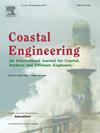分枝珊瑚和板状珊瑚群断裂概率的结构和流体力学模型
IF 4.2
2区 工程技术
Q1 ENGINEERING, CIVIL
引用次数: 0
摘要
气候变化正在加大恶劣天气事件的强度,珊瑚礁等沿海地区更容易受到气旋波的影响。为了更好地理解和预测水动力扰动对珊瑚礁的影响,已经为珊瑚群建立了预测弯曲应力和珊瑚破损的结构模型。然而,通过改进量化复杂多变的珊瑚形态的方法,这些预测还有改进的余地。本研究旨在预测两种最普遍的珊瑚形态:枝状珊瑚和板状珊瑚(以 Acropora muricata 和 Acropora hyacinthus 为研究物种)的断裂阈值。通过实验室和实地测量来评估珊瑚的形态和材料特征。在研究地点(英国大堡礁南部的苍鹭礁)调查了 47 个分支珊瑚群和 100 个板状珊瑚群的形态特征,并通过现场和实验室测试获得了 80 个珊瑚样本的抗拉强度。建立了分支珊瑚群和板珊瑚群的三维结构模型,包括从相对较浅(5-7 米)到较深(9-12 米)区域形态各异的多个珊瑚群。根据现有数据对模型结果进行了校准和验证,结果表明,1.7 米/秒和 5.0 米/秒的速度阈值将分别摧毁 90% 生长在前礁区深部和浅部的模拟分支珊瑚结构。相比之下,板珊瑚即使在极端流速条件下(7 米/秒)也有足够的安全系数。此外,根据珊瑚骨架内部不同程度的生物侵蚀,对骨架强度和结构性能进行了调整。随着生物侵蚀程度的增加,珊瑚断裂的几率也随之增加。对珊瑚群的流体动力负荷的实验室实验表明,在上升波方向上,一个或两个相邻珊瑚群的遮蔽效应可以忽略不计。这些模型可以很容易地进行调整,以便为其他珊瑚物种、形状、生物侵蚀程度和地点(如遮蔽区或暴露区)提供预测。对不同区域的预期破坏和碎石产生水平的综合预测,可用于珊瑚礁管理规划和确定修复的优先次序。本文章由计算机程序翻译,如有差异,请以英文原文为准。
Structural and hydrodynamic modelling of the probability of breakage of branching and plate coral colonies
Climate change is amplifying the intensity of severe weather events, with coastal regions such as coral reefs facing heightened vulnerability to cyclonic wave forces. Structural models to predict bending stress and breakage of corals have been developed for coral colonies to enhance comprehension and prediction of the effects of hydrodynamic disturbances on coral reefs. However, there is scope for improving these predictions by evolving the methodology for quantifying complicated and variable coral morphologies. This study aims to predict breakage thresholds for two of the most prevalent coral morphologies: branching and plate corals (using Acropora muricata and Acropora hyacinthus as study species). Laboratory and field measurements were taken to assess coral morphologies and material characteristics. Morphological features of 47 branching colonies and 100 plate colonies were surveyed at the study site (Heron Reef, southern GBR) and the tensile strength of 80 coral samples was obtained by in situ and laboratory testing. Three-dimensional structural models of branching and plate coral colonies were developed, encompassing multiple coral colonies with varying morphological patterns from relatively shallow (5–7 m) to deep (9–12 m) zones. Model results were calibrated and verified with existing data, revealing that velocity thresholds of 1.7 m/s and 5.0 m/s would destroy 90% of the simulated branching coral structures growing in the deep and shallow parts of the forereef zone, respectively. In contrast, the plate corals have sufficient margins of safety even in extreme flow conditions (7 m/s). Additionally, skeletal strength and structural performance were adjusted based on varying degrees of bioerosion inside the coral skeleton. A higher probability of breakage was observed as the extent of bioerosion increased. The laboratory experiments of hydrodynamic loads on coral colony show that the sheltering effect due to one or two neighbouring colonies in the upwave direction is negligible. These models can be easily adjusted to provide predictions for other coral species, shapes, levels of bioerosion, and locations (e.g., sheltered or exposed areas). Comprehensive predictions about the level of expected damage and rubble generation in different areas can be used in reef management planning and restoration prioritization.
求助全文
通过发布文献求助,成功后即可免费获取论文全文。
去求助
来源期刊

Coastal Engineering
工程技术-工程:大洋
CiteScore
9.20
自引率
13.60%
发文量
0
审稿时长
3.5 months
期刊介绍:
Coastal Engineering is an international medium for coastal engineers and scientists. Combining practical applications with modern technological and scientific approaches, such as mathematical and numerical modelling, laboratory and field observations and experiments, it publishes fundamental studies as well as case studies on the following aspects of coastal, harbour and offshore engineering: waves, currents and sediment transport; coastal, estuarine and offshore morphology; technical and functional design of coastal and harbour structures; morphological and environmental impact of coastal, harbour and offshore structures.
 求助内容:
求助内容: 应助结果提醒方式:
应助结果提醒方式:


